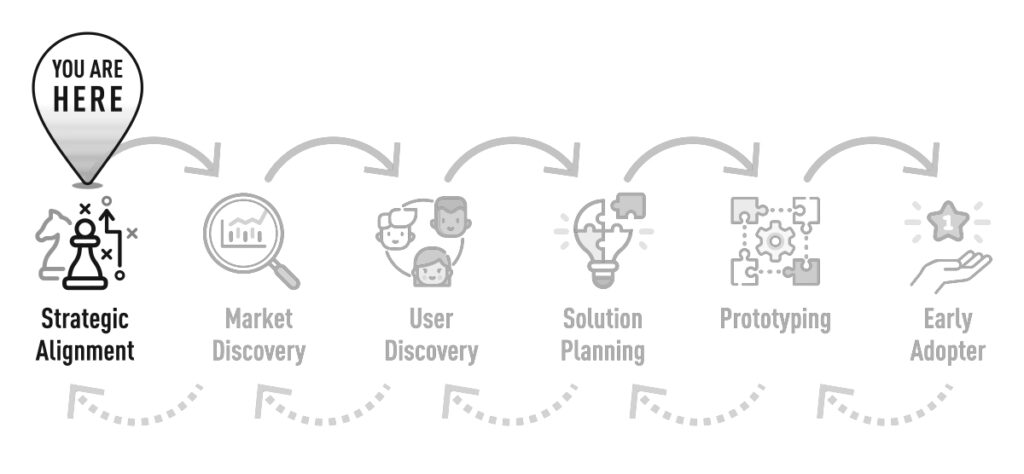
The best way to increase your chances of success when launching a new product is to ensure you clearly understand the customer problem your product will solve.
Unfortunately, many companies lack this clarity because they are focused on a technology-first approach or because the stakeholders can’t agree on the customer problem to tackle first.
Whether you are building Enterprise Software or IoT solutions, stakeholder misalignment will quickly derail your new product.
So, before diving deeper into discovery or prototyping, getting all your stakeholders aligned on the customer problem to solve is essential.
Let me illustrate with an example.
Strategic Misalignment – A Real-World Example
I once advised a company working on a new digital payment solution. They were excited about launching a new product but were not aligned on the specific customer problem they wanted to address.
The CEO stated that the new product’s goal was to make it easy for their customers to add payment capabilities to mobile apps. The Director of Operations said that the value of this new product was to enable their customers to accept payment in foreign currencies. And the CTO said their customers’ main problem was cybersecurity, so the new product was all about encryption and tracking potential fraud.
These three customer problems (mobile payments, payment in foreign currencies, and tracking fraud) were all great opportunities to pursue. The problem is that the product required to solve each of these business outcomes is very different, not to mention that the end customer that needs each of these products is different as well.
If your key stakeholders are not aligned on which customer problem to solve, you must act fast. Without this alignment, your complete innovation journey is at risk. To get everybody on the same page, I recommend a combination of one-on-one meetings and running a strategic alignment workshop.
Six Steps to Run a Successful Strategic Alignment Workshop
A strategic alignment workshop is simply a meeting (or series of meetings) with all stakeholders to discuss the differences of opinions and to align everybody on the next step.
Based on the B2B Innovator’s Map, you are here:
 There are many ways to run these workshops. The format, duration, and facilitation approach will depend on your company’s culture and personal style. The content of the workshops will revolve around affinity mapping exercises. Affinity mapping is a facilitation technique that organizes similar ideas to uncover underlying themes.
There are many ways to run these workshops. The format, duration, and facilitation approach will depend on your company’s culture and personal style. The content of the workshops will revolve around affinity mapping exercises. Affinity mapping is a facilitation technique that organizes similar ideas to uncover underlying themes.
During the workshop, your goal is to collaborate with your stakeholders to rank the opportunities they think the company should focus on and then discuss the emerging themes.
Below are the six steps to run a successful strategic alignment workshop to nail down the customer problem to explore:
- Before the workshop, have a one-on-one conversation with each stakeholder to understand what customer business outcome they believe the company should focus on.
- At the beginning of the workshop, walk everybody through the six stages of the B2B Innovator’s Map. Point out that the goal of the day’s workshop is to focus on stage one, Strategic Alignment. That way, you’ll keep everybody focused on the task at hand and ensure that your stakeholders understand you are just at the beginning of this journey.
- Using sticky notes, ask each stakeholder to write down the problem statement they believe the company should focus on. Ask every stakeholder to paste their sticky note(s) on a wall for everybody to see.
- Group the sticky notes that address the same problem.
- Facilitate a discussion to understand why multiple stakeholders suggest tackling different problems. This is an excellent time to leverage the insights you learned during your one-on-one stakeholder interviews and your market trend research.
- After hearing all the arguments, ask all stakeholders to vote on their top choice. Repeat this process until there is agreement on a single problem to go after.
As you work with your stakeholders to prioritize the customer problem to pursue, make sure the discussion focuses on a customer outcome rather than an internal business goal.
Here are some examples that focus on supporting a customer business outcome. These types of statements are what you are after in your workshop:
- “Our new product will help companies become more efficient at tracking their.”
- “A new product will make it easier for companies to take payments over the internet.”
- “Our goal is to enter a new market by creating a product that helps our customers save energy on their utility bills.”
- “We want to help marketing teams get more ROI from their advertisement campaigns.”
- “Our goal is to create a new line of products to help companies manage their human.”
Although the problem statements above are still very high-level, they provide a great deal of direction for the innovation team. At this point, you don’t have any information on which type of companies you’ll be targeting, who is your ideal customer profile, what market you will focus on, or what your potential solution will look like.
You’ll answer all those questions at later stages of the innovation journey. During the Strategic Alignment stage, your only goal is to get agreement from the executive team on the high-level customer business outcome to explore.
Be aware that it might take several workshops to reach a consensus, but that’s a good thing. The more engagement you get from all stakeholders, the more aligned they’ll be and the better chance your product will have to succeed.
The people in the room will become your allies and will help you when things get tough. Make sure you continue nurturing those relationships throughout the journey.
Related podcast episode: How to Create Clarity and Alignment Across Your Organization with Stefano Mastrogiacomo
The Bottom Line
Keeping your stakeholders aligned throughout the innovation journey takes effort, and at times, it will feel like all your time is spent getting alignment. But, the time you spend creating and nurturing stakeholder alignment will pay dividends throughout the innovation journey.
In other words, as a Product Leader, you are responsible for delivering a product the market wants and bringing your company along the journey. It’s a hard job, but with focus and consistency, I’m sure you’ll get there.